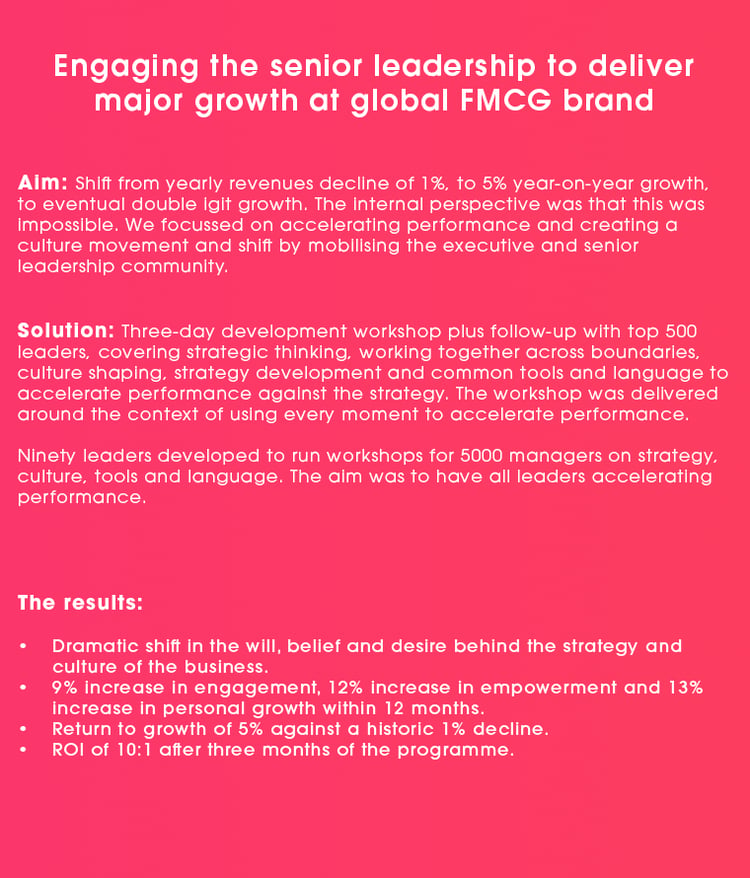Building coaching muscle: getting back to basics to develop a future-fit workforce
Leadership Blog | 4 minute read

Written by Mike Straw

The world of business is changing, we all know this. What we’ve observed at the senior leadership level is that development programmes seem to focus on areas such as agility, empowerment, external innovation, navigating in uncertain times, leading the enterprise. We agree with this approach to an extent, but there is something missing.
The role of senior leaders is changing. They’re no longer directors but visionaries, expected to catalyse change. So what new knowledge do they need to build an agile team? In most cases, the answer might surprise you.
Mike Straw explains why leading and coaching the workforce of the future is not just the above topics but getting back to basics – and how practise can build your leadership and management muscle again.
Getting back to basics
Remember being at business school? Or starting out on the management ladder? For senior leaders in your business, that was possibly 10-15+ years ago.
And the world has changed rapidly in those 15 years: think shifting to carbon neutrality, sustainable energy and AI. It’s become unpredictable – so it’s the task of senior leaders to build a future-fit workforce that is adaptable, agile and resilient. Leaders have changed too, acquiring skills and experience. They may even have been on programmes run by the big business schools about enterprise or thought leadership.
But along the way, they’ve likely grown out of the habit of exercising many of the fundamental skills and knowledge they built up early in their careers. In our experience, great leadership and management and coaching know-how are frequent casualties.
This is also borne out in the research. In one study, 86% of senior leaders said they’re good or very good at coaching. When asked the same question, only 17% of their teams agreed.[1] What this means simply is that executives and senior leaders have many moments with their teams and individuals. These can be 1-2-1s, performance development conversations, corridor conversations, all of which offer opportunities to empower, develop, catalyse their people. But too often, this doesn’t happen. A massive missed opportunity.
[1] The Leader’s Voice, Clarke and Crossland
![AB Website stats[2]_Page_1](https://thinking.achievebreakthrough.com/hs-fs/hubfs/AB%20Website%20stats%5B2%5D_Page_1.png?width=5334&height=3000&name=AB%20Website%20stats%5B2%5D_Page_1.png)
Leadership: from controller to architect
Everyone want to have an empowered workforce but what drives me crazy is that people already have power. The issue is that somehow many organisations take that power away. We believe that you want to put people back in touch with the power they have and create the conditions for them to exercise that power. That’s true empowerment.
The role of senior leaders is no longer as planners, directors and controllers of people. Instead, they have to become visionaries, architects of change, coaches and catalysts. The way to get there is through coaching. Just imagine if we held every interaction every day as an opportunity to build a person, a team. These are the muscles that often become weaker as leaders become more senior. They need waking up and toning!
Getting back to basics: Coaching to cultivate innovation
Above all, senior leaders are caught in a polarity between giving autonomy and giving direction. They have to be fabulous at coaching, performance management, growth conversations and development conversations. They have to unblock the way for people.
It’s worth pausing here to consider what we really mean by ‘coaching’, as very often the expectations of leaders and their teams differ. It may be helpful to consider the following definition: ‘Coaching is unlocking a person’s potential to maximise their own performance. It is helping them to learn rather than teaching them.’[2]
Recently, we were designing a program with a leader who said: “I coach all the time, I have lots of one-to-ones in my team.” When we dug into the basics of coaching, which is unlocking people's potential, realisation came: “I don’t really coach my people.” Instead, they often tell their teams what they would do in a certain situation.
At one level this is fine, but every time you tell, you become an accidental diminisher of someone’s learning and growth. That doesn’t mean you should never tell, but you should question what is the most powerful intervention in every moment. For anyone looking for more insight on this point, Simon Sineck has a great video which brings this point alive for me.
The ability to give feedback to grow people's performance and development is becoming more and more important. But the catch here is that senior leaders have less time nowadays to develop people, because the world is getting quicker and quicker.
[2] Whitmore, 2009
Honing your management muscle
We are adapting our leadership programmes to include putting senior leaders back in touch with all those basic skills, disciplines and practices they learned in business school, or on their induction. It’s not about acquiring new knowledge – most leaders have fundamental knowledge in abundance. It’s about getting fit and practised again. The emphasis is on helping your leaders sharpen the saw through guided facilitation. They’re focused on experiential practice, in peer groups and this builds that network of support and shifts the culture
We call it the art rather than the science of leadership. Basic skills and knowledge are the science of leadership. Practising, honing and deploying them is the art.
And we know it works. One of the big organizations we’re working with did a deep dive on leadership effectiveness. They discovered that if leaders could get a one point increase in doing the basics right, their organisation would have a 15% increase in its Employee Net Promoter Score (ENPS) score in 6 months.
Practising effective management
A magic circle law firm following our approach saw a 73% rise in the perceived effectiveness of managers when it came to performance management, and a 48% rise in the perceived effectiveness of managers in enabling staff to perform their best. And 98% of managers said the approach to developing their teams had helped them identify key strengths to enable individuals to perform at their best.
It was all down to higher quality performance conversations with employees focused on strengths, high performance development and increased team motivation. All those basics your senior leadership team learned in business school.
So, if you’d like to work with us to rebuild your top team’s management muscle, get in contact today. We’d love to hear from you.

Published 09/04/2024
Subscribe by Email
Achieve more breakthroughs. Get expert leadership ideas, insights and advice straight to your inbox every Saturday, as well as the occasional bit of news on us, such as offers and invitations to participate in things like events, webinars and surveys. Read. Lead. Breakthrough.
Related posts
Leadership Blog
Leadership burnout: Expanding bandwidth to thrive through complexity
Achieve Breakthrough | 16/12/2025
Leadership Blog
What triggers you as a leader, and how to work with it?
Achieve Breakthrough | 09/12/2025
Leadership Blog
Why it’s impossible to lead with one foot still in your old role
Achieve Breakthrough | 03/12/2025
Leadership Blog
Why a leader’s true value lies in what they enable, not just what they know
Achieve Breakthrough | 25/11/2025
